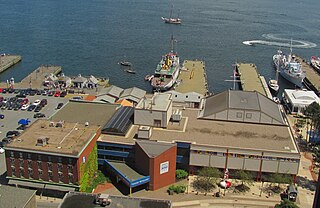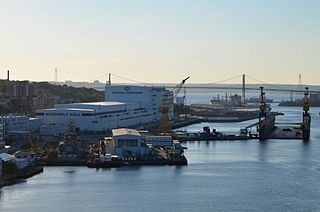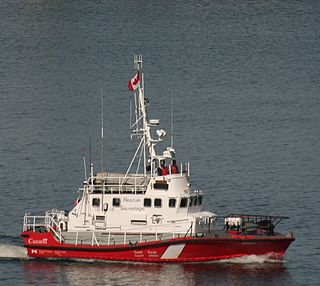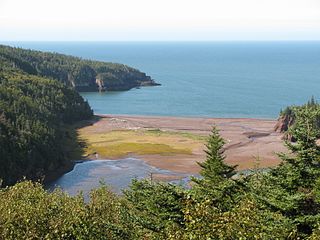Related Research Articles

The Maritime Museum of the Atlantic is a maritime museum located in downtown Halifax, Nova Scotia, Canada.

SS Atlantic was a transatlantic ocean liner of the White Star Line that operated between Liverpool, United Kingdom, and New York City, United States. During the ship's 19th voyage, on 1 April 1873, she struck rocks and sank off the coast of Nova Scotia, Canada, killing at least 535 people. It remained the deadliest civilian maritime disaster in the North Atlantic Ocean until the sinking of SS La Bourgogne on 2 July 1898 and the greatest disaster for the White Star Line prior to the loss of Titanic in April 1912.

Halifax Harbour is a large natural harbour on the Atlantic coast of Nova Scotia, Canada, located in the Halifax Regional Municipality. The town of Halifax largely owes its existence to the harbour, being one the largest and deepest ice-free natural harbours in the world. Before Confederation it was one the most important commercial ports on the Atlantic seaboard. In 1917, it was the site of the world's largest man-made accidental explosion, when the SS Mont-Blanc blew up in the Halifax Explosion of December 6.

Theodore Tugboat is a Canadian children's television series about a tugboat named Theodore who lives in the Big Harbour with all of his friends. The show originated in Halifax, Nova Scotia, Canada as a co-production between the CBC, and the now defunct Cochran Entertainment, and was filmed on a model set using radio controlled tugboats, ships, and machinery. Production of the show ended in 2001, and its distribution rights were later sold to Classic Media. The show premiered in Canada on CBC Television, then went to PBS, was on Qubo in the United States, and has appeared in eighty different countries.
USS Pontiac (AF-20) was a stores ship acquired by the U.S. Navy for use in World War II. She served as a refrigerator ship or reefer ship, and provided food to Allied forces in the North Atlantic Ocean.

Sambro Island Lighthouse is a landfall lighthouse located at the entrance to Halifax Harbour, Nova Scotia, on an island near the community of Sambro in the Halifax Regional Municipality. It is the oldest surviving lighthouse in North America and its construction is a National Historic Event.

The Halifax Shipyard Limited is a Canadian shipbuilding company located in Halifax, Nova Scotia.

CCGS Sambro is a Canadian Coast Guard motor lifeboat homeported in Sambro, Nova Scotia.

Eatonville is a former lumber and shipbuilding village in Cumberland County, Nova Scotia. It includes a large tidal harbour at the mouth of the Eatonville Brook beside several dramatic sea stacks known as the "Three Sisters". It was founded in 1826 and abandoned in the 1940s. The site of the village is now part of Cape Chignecto Provincial Park.
Persier was a 5,382 GRT cargo ship which was built in 1918 as War Buffalo for the British Shipping Controller. In 1919, she was sold to Belgium and renamed Persier. Between 1934 and 1941 she also held a passenger certificate. She was driven ashore on the Icelandic coast in a storm in February 1941 which put her out of action for two years. Returned to service in February 1943, she served until 11 February 1945, when she was torpedoed and sunk by U-1017 with the loss of 20 crew.

SSMont-Blanc was a freighter built in Middlesbrough, England in 1899 and purchased by the French company, Société Générale de Transport Maritime (SGTM). On Thursday morning, 6 December 1917, she entered Halifax Harbour in Nova Scotia, Canada laden with a full cargo of highly volatile explosives. As she made her way through the Narrows towards Bedford Basin, she was involved in a collision with SS Imo, a Norwegian ship. A fire aboard the French ship ignited her cargo of wet and dry 2300 tons of picric acid, 200 tons of TNT, and 10 tons of guncotton. The resultant Halifax Explosion levelled the Richmond District and killed approximately 2,000 people, and the injured may have been approximately 9,000.

SS Imo was a steamship that served in passenger and freight trades and later as a whaling supply ship. Christened SS Runic, she was bought, sold and renamed numerous times during her career. In 1917, Imo was under Norwegian registry chartered by the Belgian Relief Commission to bring supplies to war-ravaged Europe.

Point Chebucto is a harbour tug that was built at the Halifax Shipyard in Halifax, Nova Scotia, Canada in 1992. She is one of very few harbour tugs that were built at the Halifax Shipyards. She has been aiding ships in and out of Halifax Harbour and later Port Hawkesbury, Nova Scotia since she was registered in January 1993. The tug was built for Eastern Canada Towing Limited, a company that has been around for over 60 years. The tug is named after the point at Chebucto Head, continuing the tradition of Eastern Canada Towing of naming its tugs after points. Eastern Canada Towing took over Foundation Maritime's work in the field of Harbour, Coastal and Deep-Sea tow and salvage. The firm owns and operate a fleet of modern tugs ranging from 1250 HP - 5400 HP. Most tugs are ice strengthened, with several having Ice Class 1 certification. Their head office is also in Halifax. Eastern Canada Towing was purchased in 2007 by Svitzer, a tug boat division of Maersk.

Sir Charles Ogle was a ferry that operated from 1830 until 1894 for the Halifax-Dartmouth Ferry Service. The ferry was the first steamship built in Nova Scotia and the longest serving ferry in Halifax Harbour. The ship is named for Royal Navy officer Sir Charles Ogle, 2nd Baronet, who served as Commander-in-Chief of North America and West Indies Station from 1827 to 1830.
SS Havana was a one deck steamship schooner equipped with three masts. She was built in 1891 at Hantsport, Nova Scotia by George W. Churchill. Owned by Farquhar, J.A. & Co. and captained by James A. Farquhar, Havana sank at anchor on 26 April 1906 after colliding with SS Strathcona.
HMCS Transcona was a Bangor-class minesweeper built for the Royal Canadian Navy during the Second World War. She was launched on 26 April 1941. After the war, she was transferred to the Royal Canadian Mounted Police under the name French. The vessel served until 1961 before being sold for scrap and broken up later that year.
The FV Flora Alberta was a Canadian auxiliary fishing schooner based out of Lunenburg, Nova Scotia. She was launched in 1941 by Smith and Rhuland, the company's 187th vessel. The managing owner of the vessel was fishing company Adams & Knickle.
HMCS Grandmère was a Bangor-class minesweeper constructed for the Royal Canadian Navy during the Second World War. Entering service in 1941, the minesweeper took part in the Battle of the Atlantic and the Battle of the St. Lawrence before being taken out of service in 1945. The ship was sold for mercantile service following the war, first as the yacht Elda and then the cargo ship Jacks Bay. The ship was sold for scrap in 1968.
City of Brunswick was a steam cargo ship built in 1921 by Oscar Daniels Shipbuilding Company of Tampa for the United States Shipping Board as part of the wartime shipbuilding program of the Emergency Fleet Corporation (EFC) to restore the nation's Merchant Marine. The freighter ran aground and was wrecked on her first commercial trip to Europe off Halifax in August 1921.
SS Cornwallis was a 5,438 gross register tons (GRT) steam merchant ship built in 1921 for the Canadian Government as Canadian Transporter. In 1932 she was transferred to Canadian National Steamships Ltd and renamed SS Cornwallis. She was sunk on 3 December 1944 after being torpedoed by the German submarine U-1230 on its way to St John with a loss of 43 crew.
References
- 1 2 "Erg". Shipwrecks of Nova Scotia. Archived from the original on December 31, 2005.
- 1 2 "Erg - 1943". Maritime Museum of the Atlantic. Retrieved 2015-04-17.
- ↑ Tucker, Gilbert Norman (1952). The Naval Service of Canada: Its Official History: Volume II: Activities on Shore During The Second World War. Ottawa: King's Printer. [ page needed ]
- 1 2 3 "New Shipwreck Display Opens at the Maritime Museum". Province of Nova Scotia. November 13, 2003. Retrieved 2015-04-17.